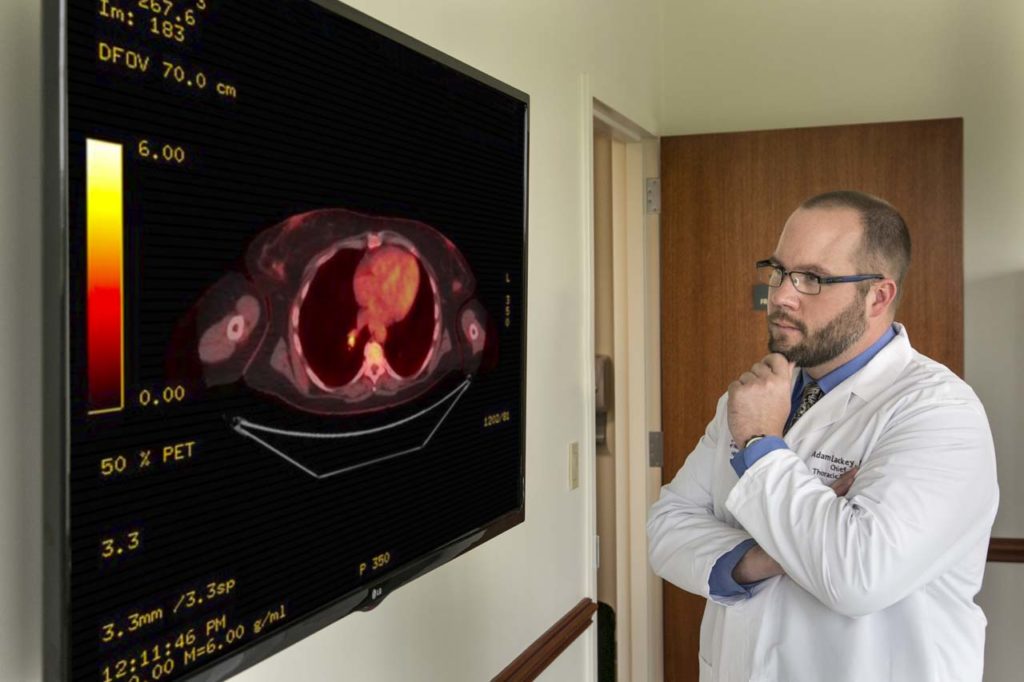A HIGHLY REGARDED THORACIC SURGEON JOINS THE STAFF AT STATEN ISLAND UNIVERSITY HOSPITAL, WITH PLANS TO BUILD ON THE SUCCESS OF ITS CARDIAC TEAM
BY JESSICA JONES-GORMAN • PHOTOS BY AMESSÉ PHOTOGRAPHY
When Dr. Adam Lackey joined Staten Island University Hospital this spring as chief of its division of thoracic surgery, he made clear his vision of building on the success of the hospital’s cardiac team by bringing a focus to thoracic surgery, working with the collaborative care team of oncologists, pulmonologists, radiologists, and pathologists.

“My job here is to build upon the reinvention of this program and focus on non-heart-related surgeries and procedures,” Lackey said. “My area of expertise focuses on the lung and esophagus anything happening inside of the chest and the goal of this department is clear: to accurately diagnose and treat tumors, trauma, and disease right here in Staten Island, because no patient who lives in this borough should have to leave it to seek proper medical care.”
Lackey’s arrival coincides with the release of a yearlong study, ordered by New York Governor Andrew Cuomo, into the borough’s health. According to data from the New York State Department of Health, cancer rates on Staten Island lead the city especially lung cancer, which is 20 percent higher here than in other boroughs causing SIUH to recruit a dedicated thoracic specialist to help address the situation.
“We recognized the need for a dedicated surgeon to treat these non-cardiac-related cases,” said Dr. Mohammed Imam, chairman of cardiothoracic surgery at SIUH. “Before Dr. Lackey’s arrival, the cardiothoracic team was splitting time between cardiac surgery cases and treating thoracic oncology patients. He joins our team at the right place and the right time.”

Lackey will be behind the controls of the hospital’s most advanced minimally invasive robotic platform, the da Vinci XI robotic platform and VATS (video-assisted thoracic surgery), to perform lobectomy, thymectomy, and plication of the diaphragm. This minimizes incisions, reducing both pain and the risk of infection. Lackey is also using minimally invasive approaches to treat benign and malignant esophageal disease, including esophageal cancer, reflux disease, and hiatal hernias.
“This is an exciting opportunity,” said Lackey. “We’re utilizing the Centers for Medicare & Medicaid Services’ lung cancer screening guidelines to help identify early stage lung cancers while they’re still treatable. Coupled with the hospital’s recent recognition from the Commission on Cancer, the timing is just right to tackle this need.”
A native of Virginia, Lackey went to medical school at the University of Virginia. After doing his general surgery residency at the University of Colorado, he completed a cardiothoracic fellowship at NYU’s Tisch Hospital, and worked at Bellevue and the Manhattan VA Medical Center. Lackey also worked in the Beaumont Health System outside of Detroit. His particular interests include minimally invasive strategies to approach both benign and malignant thoracic pathologies, including esophageal pathology. He is certified by the American Board of Thoracic Surgeons and the American Board of Surgery, and has numerous publications to his credit, including a paper on “Thoracic Surgery Clinics and Seminars in Interventional Radiology.”
Lackey recognizes the vast changes that have occurred in his specialty over the past decade.
“When I first started my fellowship, there was no question that minimally invasive and robotic techniques would be the future of thoracic surgery,” he said. “And over the years, we have certainly pushed the boundaries with smaller incisions, which allow for much easier procedures and recoveries. But interestingly enough, surgeons have been performing the same operation for lung cancer taking out the affected lobe of the lung and leaving the healthy tissue behind—since the 1930s. We’re still using that same treatment, but have refined it with a smaller incision and the robotic platform.”
One of the biggest revolutions in treating thoracic oncology patients, Lackey added, is targeted drug therapy.

“Such drug therapies for those with advanced cancers have shown very promising benefits,” he said. “It’s extremely refreshing to discuss a patient in a multidisciplinary tumor board and be able to give a recommendation of something other than old-fashioned chemotherapy. And for many patients, these drugs have been well tolerated and successful.”
Lackey also points to recent advances in the evolution of cancer screening.
“Higher-quality scanning modalities are allowing us to pick up on more cancers earlier than we would have in the past,” he said. “And because lung cancer can be asymptomatic until the tumor reaches a more advanced stage, this is a big deal for our specialty.”
The attention now being paid to lung cancer is perhaps the most promising advance in his field, said Lackey. “ ere are more than 200,000 cases of lung cancer each year in the U.S. alone, and it’s the leading cause of cancer deaths in this country among both men and women.”
Which brings him back to the special needs on Staten Island. “New York State has recognized those statistics and has acknowledged that this borough needs special attention,” he said. “ at recognition, combined with all of the medical innovation, indicates the approach of a very exciting era for this specialty.”

Staten Island University Hospital / Northwell Health
475 Seaview Avenue / 718.226.9000 /
northwell.edu
